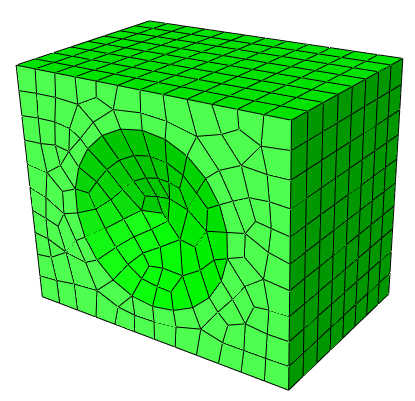Geometry and model
The model is shown in Figure 1. The system considered here consists of a speaker box, a speaker cone, and the interacting interior. To simplify the problem, the effect of interacting air at the outside of the speaker box is neglected. The width, depth, and height of the speaker box are 0.5 m, 0.4 m, and 0.6 m, respectively. Its thickness is 0.005 m. The speaker box is made of wood with a Young's modulus, E, of 11.6 GPa; a Poisson's ratio, , of 0.3; and a density, , of 562 kg/m3. At the center of the front speaker box, there is a cone-shaped speaker 0.345 m in diameter, 0.04 m in height, and 0.001 m in thickness. No mass or impedance of the speaker is considered. The speaker is made of polyethylene with a Young's modulus, E, of 3.4 GPa; a Poisson's ratio, , of 0.3; and a density, , of 450 kg/m3. The air has a density, , of 1.11 kg/m3 and a bulk modulus, , of 0.134 MPa. Volumetric drag of the air is assumed to have a negligible effect in this problem, so it is ignored in this analysis.
First-order hexahedral acoustic elements (AC3D8) and first-order acoustic triangular prism elements (AC3D6) are used to fill in the volume of the interior air region. The speaker box and speaker are meshed with S4R and S3R elements, respectively. No mesh convergence study has been done since the example is intended only as an illustration. The choice of mesh density (element size) is discussed in Acoustic, Shock, and Coupled Acoustic-Structural Analysis.
The surface-based tie constraint is used to couple the structure with the air inside. Surfaces are defined at the inside of the speaker box and the speaker cone and at the free surface of the air. To constrain the structure, four corner points of the bottom panel are simply supported.
A substructure analysis is performed as well. The entire speaker model is turned into a dynamic coupled structural-acoustic substructure using all the eigenmodes up to 800 Hz. A substructure load case is generated to be used in the forced response analyses.

